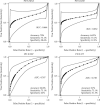Evaluation of Brain SPECT with 99mTc-TRODAT-1 in the Differential Diagnosis of Parkinsonism
- PMID: 35300121
- PMCID: PMC8923776
- DOI: 10.1155/2022/1746540
Evaluation of Brain SPECT with 99mTc-TRODAT-1 in the Differential Diagnosis of Parkinsonism
Abstract
Introduction: Brain SPECT with 99mTc-TRODAT-1 (SPECT-TRODAT) may be a useful tool in the differential diagnosis of Parkinsonism.
Objective: To compare results of SPECT-TRODAT with clinical findings in patients with Parkinsonism.
Methods: We evaluated 153 outpatients. SPECT-TRODAT results were visually analyzed into normal, abnormal, symmetric, and asymmetric, and according to the degree of impairment into mild, moderate, marked, and severe (1-4).
Results: A direct relationship was found between motor scores severity (MDS-UPDRS-III) and SPECT-TRODAT-reduced binding in general, in the group of patients with synucleinopathies (rho = 0.258, p=0.005), especially in patients with Parkinson's disease (rho = 0.204, p=0.049). Changes in SPECT-TRODAT had high correspondence with symmetry in all Parkinsonism. When comparing groups to the correspondence predominantly bilateral or unilateral impairment in SPECT, there was a difference between patients with SNP (p=0.041) and between this group and patients with secondary Parkinsonism (SP) (p < 0.0001). It was handy in differentiating drug-induced Parkinsonism from synucleinopathies. In the group of drug-induced Parkinsonism, younger people were the ones who showed the most significant reductions in radiotracer uptake. In this group, nonmotor signs resulted in examinations with more significant reductions in radiotracer uptake. When the scans without alterations and those that did not correspond to the symmetry were considered negative, SPECT-TRODAT's accuracy and specificity to differentiate PD from other forms of Parkinsonism were low. There was an inverse correlation between the severity of the SPECT-TRODAT result and the absence of nonmotor signs in patients with drug-induced Parkinsonism.
Conclusion: The authors concluded that the SPECT with 99mTc-TRODAT-1 was mainly useful in differentiating between synucleinopathies and secondary Parkinsonism.
Copyright © 2022 Giorgio Fabiani et al.
Conflict of interest statement
The authors declare that they have no conflicts of interest.
Figures


References
-
- Munhoz R. P., Werneck L. C., Teive H. A. G. The differential diagnoses of Parkinsonism: findings from a cohort of 1528 patients and a 10-years comparison in tertiary movement disorders clinics. Clinical Neurology and Neurosurgery . 2010;112(5):431–435. - PubMed
-
- Camargo C., Della-Coletta M. V., Da Silva D. J., Teive H. In: Handbook of Research on Critical Examinations of Neurodegenerative Disorders . Sahab Uddin Md., Shah Amran Md., editors. IGI Global, Pennsylvania, PA, USA: 2019. pp. 274–297. - DOI
LinkOut - more resources
Full Text Sources
Research Materials
Miscellaneous

